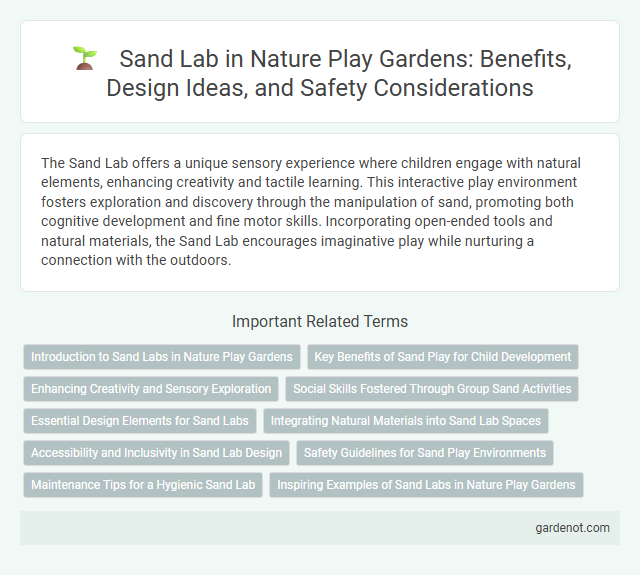The Sand Lab offers a unique sensory experience where children engage with natural elements, enhancing creativity and tactile learning. This interactive play environment fosters exploration and discovery through the manipulation of sand, promoting both cognitive development and fine motor skills. Incorporating open-ended tools and natural materials, the Sand Lab encourages imaginative play while nurturing a connection with the outdoors.
Introduction to Sand Labs in Nature Play Gardens
Sand labs in nature play gardens offer interactive, sensory-rich environments where children explore creativity and physics through hands-on sand manipulation. These spaces encourage cognitive and motor skills development by engaging kids in activities such as building, digging, and shaping natural sand structures. Incorporating features like water channels and natural materials enhances environmental learning and fosters problem-solving abilities in outdoor settings.
Key Benefits of Sand Play for Child Development
Sand play fosters sensory development by stimulating tactile exploration and fine motor skills in children. It enhances cognitive growth through problem-solving, creativity, and spatial awareness as kids experiment with shapes and structures. Social skills improve as children collaborate, communicate, and negotiate roles during shared sandplay activities.
Enhancing Creativity and Sensory Exploration
Sand labs provide children with a rich environment for enhancing creativity and sensory exploration through tactile play. Engaging with sand textures and shapes stimulates fine motor skills, cognitive development, and imaginative thinking. These interactive sand experiences encourage problem-solving and sensory integration, vital for early childhood growth.
Social Skills Fostered Through Group Sand Activities
Group sand activities in a Sand Lab enhance social skills such as communication, cooperation, and conflict resolution among children. Collaborative tasks encourage sharing ideas, negotiating roles, and working towards common goals, promoting empathy and teamwork. These interactive experiences help develop emotional intelligence and strengthen peer relationships in a natural play setting.
Essential Design Elements for Sand Labs
Essential design elements for sand labs include a spacious, naturalistic sandbox with varied textures such as fine sand and gravel to stimulate sensory exploration. Incorporating movable tools like scoops, buckets, and molds encourages creativity and fine motor skill development. Proper drainage and shaded areas ensure a safe, comfortable environment for extended play sessions.
Integrating Natural Materials into Sand Lab Spaces
Integrating natural materials into Sand Lab spaces enhances tactile learning experiences by providing children with diverse textures such as smooth river stones, coarse pine cones, and soft moss. These elements stimulate sensory exploration and encourage creative play, promoting fine motor skills and cognitive development. Incorporating organic components also fosters environmental awareness and connection to nature within interactive sand play environments.
Accessibility and Inclusivity in Sand Lab Design
Sand Lab designs prioritize accessibility by incorporating smooth, wide pathways and adjustable-height sand tables to accommodate children with mobility challenges. Inclusive features such as tactile sensory panels and varied sand textures ensure engagement for children with diverse sensory needs. Visual contrast and clear signage support users with visual impairments, fostering an inviting environment for all abilities.
Safety Guidelines for Sand Play Environments
Sand labs designed for nature play require strict adherence to safety guidelines, including regular sand quality testing to prevent contamination and health risks. Surfaces must be maintained to avoid sharp objects or debris, while ensuring adequate drainage to prevent water stagnation and bacterial growth. Supervision protocols and hand-washing stations further reduce the risk of infections and promote a safe, hygienic environment for children.
Maintenance Tips for a Hygienic Sand Lab
Regularly sift and replace sand to prevent buildup of debris and bacteria in a sand lab. Use natural, non-toxic cleaning solutions to sanitize surfaces and tools without harming the environment or children's health. Cover the sand lab when not in use to protect it from contaminants like dust, insects, and pets.
Inspiring Examples of Sand Labs in Nature Play Gardens
Sand labs in nature play gardens foster creativity and sensory development by offering dynamic, tactile experiences with natural materials. These spaces often include varied textures, natural tools, and open-ended play opportunities that encourage exploration and social interaction among children. Prominent examples, such as the Quarry Hill Nature Center and the Smith Family Sandbox, highlight the integration of ecological education with imaginative play, promoting environmental awareness through hands-on learning.
Sand lab Infographic

 gardenot.com
gardenot.com